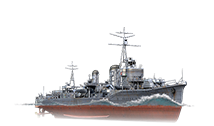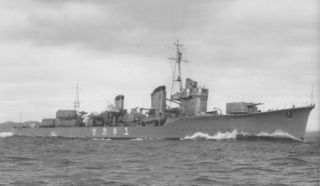PJSD010 Kagero 1943
| Revision as of 19:18, 18 August 2015 added historical image description | Revision as of 02:25, 22 September 2015 | |||
| Line 9: | Line 9: | |||
| ? | Those who drafted the Imperial Navy's 1937 and 1939 building programs blurred the dividing lines between them (and between the KAGERO and YUGUMO classes as a result) by adding in five fictitious destroyers, this to help conceal the resource allocations being devoted to the huge battleships of the YAMATO class. The first 15 units of the KAGERO class (hull numbers 17-31) were authorized under the 1937 Program — as were the fictitious numbers 32-34. The last four, designated the ARASHI group (hull numbers 112-115), followed in the 1939 Program -- along with the first 11 YUGUMOs, SHIMAKAZE, and a couple more counterfeits. Postwar officials, primarily unqualified army and government clerks rather than navy men (though the latter did include the formidable Fukui Shizuo), tried to unscramble and make sense of these plans and the various documents that supported them. In so doing, and probably further mislead simply by her name, they placed No. 115 AKIGUMO on "the wrong side of the ledger," with No. 116 YUGUMO and her sisters. | + | Those who drafted the Imperial Navy's 1937 and 1939 building programs blurred the dividing lines between them (and between the KAGERO and YUGUMO classes as a result) by adding in five fictitious destroyers, this to help conceal the resource allocations being devoted to the huge battleships of the YAMATO class. The first 15 units of the KAGERO (陽炎) class (hull numbers 17-31) were authorized under the 1937 Program — as were the fictitious numbers 32-34. The last four, designated the ARASHI group (hull numbers 112-115), followed in the 1939 Program -- along with the first 11 YUGUMOs, SHIMAKAZE, and a couple more counterfeits. Postwar officials, primarily unqualified army and government clerks rather than navy men (though the latter did include the formidable Fukui Shizuo), tried to unscramble and make sense of these plans and the various documents that supported them. In so doing, and probably further mislead simply by her name, they placed No. 115 AKIGUMO on "the wrong side of the ledger," with No. 116 YUGUMO and her sisters. | |
| The KAGEROs benefitted greatly from the many teething troubles of the previous ASASHIO class, and as a result experienced almost none of their own. Virtually identical in appearance to their predecessors, they also mounted the same armament of six 5" guns in Type C turrets, and eight 24" torpedo tubes. Although the KAGEROs were some 72 tons heavier and sported a slightly thicker bridge structure, their stability was improved by lowering the fore quadruple torpedo tube mount and moving its reloads forward abaft the bridge. One unit, the AMATSUKAZE, was fitted with experimental high-pressure boilers, but her performance was not markedly superior to that of her sisters. | The KAGEROs benefitted greatly from the many teething troubles of the previous ASASHIO class, and as a result experienced almost none of their own. Virtually identical in appearance to their predecessors, they also mounted the same armament of six 5" guns in Type C turrets, and eight 24" torpedo tubes. Although the KAGEROs were some 72 tons heavier and sported a slightly thicker bridge structure, their stability was improved by lowering the fore quadruple torpedo tube mount and moving its reloads forward abaft the bridge. One unit, the AMATSUKAZE, was fitted with experimental high-pressure boilers, but her performance was not markedly superior to that of her sisters. | |||
Revision as of 02:25, 22 September 2015
| kt Max Speed |
| s Rudder Shift Time |
| m Turn Radius |
| - mm Hull Armor |
| - mm Citadel Armor |
| - mm Deck Armor |
| - mm Extremities Armor |
| Guns |
| Guns |
| Torpedoes |
| Recon Squadrons |
| km Aerial Detection Range |
| km Surface Detection Range |
Modules
Compatible Equipment
Historical Info
Those who drafted the Imperial Navy's 1937 and 1939 building programs blurred the dividing lines between them (and between the KAGERO and YUGUMO classes as a result) by adding in five fictitious destroyers, this to help conceal the resource allocations being devoted to the huge battleships of the YAMATO class. The first 15 units of the KAGERO (陽炎) class (hull numbers 17-31) were authorized under the 1937 Program — as were the fictitious numbers 32-34. The last four, designated the ARASHI group (hull numbers 112-115), followed in the 1939 Program -- along with the first 11 YUGUMOs, SHIMAKAZE, and a couple more counterfeits. Postwar officials, primarily unqualified army and government clerks rather than navy men (though the latter did include the formidable Fukui Shizuo), tried to unscramble and make sense of these plans and the various documents that supported them. In so doing, and probably further mislead simply by her name, they placed No. 115 AKIGUMO on "the wrong side of the ledger," with No. 116 YUGUMO and her sisters.
The KAGEROs benefitted greatly from the many teething troubles of the previous ASASHIO class, and as a result experienced almost none of their own. Virtually identical in appearance to their predecessors, they also mounted the same armament of six 5" guns in Type C turrets, and eight 24" torpedo tubes. Although the KAGEROs were some 72 tons heavier and sported a slightly thicker bridge structure, their stability was improved by lowering the fore quadruple torpedo tube mount and moving its reloads forward abaft the bridge. One unit, the AMATSUKAZE, was fitted with experimental high-pressure boilers, but her performance was not markedly superior to that of her sisters.
Upon completion the KAGEROs were the equal of any of their contemporaries in other navies and superior to most. Only the initial lack of radar and continued poor quality of sonar equipment -- shortcomings which bedeviled all Japanese destroyers -- hindered their performance. These were never completely made good, but early deficiencies in antisubmarine and antiaircraft weaponry soon were. As in many other classes, depth charge stowage was increased to 36 and four throwers were added. Light AA armament also grew steadily, and eventually numbered twenty-eight 25 mm. machine guns following removal of the "X" gun turret from all surviving ships of the class, in late1943-early 1944, in favor of two triple 25mm. mounts. (Those so altered included AKIGUMO — but none of the YUGUMO class!)
Around the end of 1942 HAMAKAZE became the first destroyer in the Japanese Navy to be fitted with radar, shipping a Type 22 set. Her sisters were then likewise equipped as they rotated homeward from the front for refitting.
At the beginning of the Pacific War the KAGEROs formed the backbone of the Empire's first-line destroyer strength, comprising the 4th, 15th, 16th, 17th and half of the 18th Destroyer Divisions. ("Orphan" AKIGUMO, to even-up numbers -- and further confuse matters! -- was later assigned to the YUGUMO-equipped Desdiv 10.)
The greatest of all the KAGEROs was unquestionably the YUKIKAZE. That fine ship not only survived the war, but did it the hard way, taking part in countless surface, air-sea and antisubmarine actions in the war's toughest theaters, yet always emerging with little or no damage. Equally robust, if less fortunate, were AKIGUMO, NOWAKI and the entire 17th Destroyer Division.
Japan's Southeast Area of the Pacific was hardest on them, six of the class being lost in the Solomons and two off Eastern New Guinea. Most of those that came through this rugged campaign survived into the last year of the war, but only YUKIKAZE was still afloat at its end. Altogether, six were sunk by air attack, five by submarines, five by surface forces and one by mine, with another two succumbing to a combination of mines and aircraft.
General Characteristics:
Type: Destroyer
Displacement: 2,000 long tons (2,032 t) standard 2,500 long tons (2,540 t) battle condition
Length: 118.50 m (388 ft 9 in) full, 116.20 m (381 ft 3 in) waterline
Beam: 10.80 m (35 ft 5 in)
Draught: 3.76 m (12 ft 4 in)
Propulsion: 3 × Kampon water tube boilers, 2 × Kanpon impulse turbines, 2 × shafts, 52,000 shp
Speed: 35.5 knots (40.9 mph; 65.7 km/h)
Complement: 239 (Kagerō, 1939)
Armament: (Kagerō, 1939)
- 6 × Type 3 127 mm 50 caliber naval guns (3×2)
- 4 × 25 mm Type 96 AA guns
- 8 × Type 92 torpedo tubes (2×4) 16 × 610 mm Type 93 torpedoes
- 18 × Type 95 depth charges
- 2 × paravanes
(Kagerō, 1943)
- 6 × Type 3 127 mm 50 caliber naval guns (3×2)
- 8 × 25 mm Type 96 AA guns
- 8 × Type 92 torpedo tubes (2×4) 16 × 610 mm Type 93 torpedoes
- 18 × Type 95 depth charges
- 2 × paravanes
(Yukikaze, July 1944)
- 4 × Type 3 127 mm 50 caliber naval guns (2×2)
- 24 × 25 mm Type 96 AA guns
- 4 × 13 mm Type 95 AA guns
- 8 × Type 92 torpedo tubes (2×4) 16 × 610 mm Type 93 torpedoes
- 36 × Type 2 or Type 3 depth charges
(Yukikaze, April 1945)
- 4 × Type 3 127 mm 50 caliber naval guns (2×2)
- 27 × 25 mm Type 96 AA guns
- 4 × 13 mm Type 95 AA guns
- 8 × Type 92 torpedo tubes (2×4) 16 × 610 mm Type 93 torpedoes
- 36 × Type 2 or Type 3 depth charges
Historical Gallery
Sources and External Links
| Destroyers | |
| Cruisers | |
| Battleship | |
| Aircraft Carriers |
| USA | |
| UK | |
| USSR | |
| Japan |

